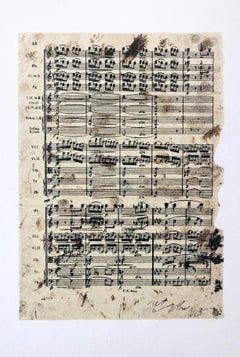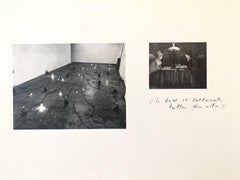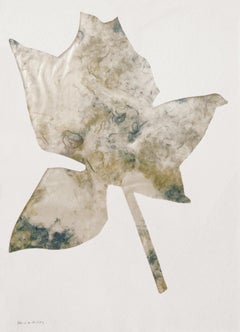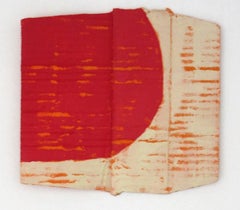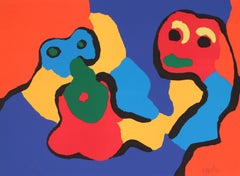Arte Povera Art
to
4
1
1
4
1
4
1
Overall Height
to
Overall Width
to
3
2
1
1
1
1
5
5
11
9
8
6
5
4
1
Style: Arte Povera
Artist: Jannis Kounellis
Photo Lithograph Jannis Kounellis Arte Povera Italian Avant Garde Etching
Located in Surfside, FL
'Lo faro il litterato tutta la vita'
Photo Lithography on rag paper
hand signed lower right in pencil: Kounellis
numbered 37/90.
Provenance: The Collection of Ileana Sonnabend (Mrs L...
Category
1960s Arte Povera Art
Materials
Lithograph
Elettra, Music Score Lithograph Jannis Kounellis Arte Povera Italian Avant Garde
Located in Surfside, FL
It depicts a musical score or music notes.
Offset Lithography on rag paper
hand signed lower right in pencil: Kounellis
numbered 37/90.
Provenance: The Collection of Ileana Sonnabend...
Category
1960s Arte Povera Art
Materials
Lithograph
Elettra, Music Score Lithograph Jannis Kounellis Arte Povera Italian Avant Garde
Located in Surfside, FL
It depicts a musical score or music notes.
Offset Lithography on rag paper
hand signed lower right in pencil: Kounellis
numbered 37/90.
Provenance: The Collection of Ileana Sonnabend (Mrs Leo Castelli) & the Estate of Nina Castelli Sundell
I have seen this piece identified as being 1969 and I have seen it as 1972.
Spartito musicale.
Jannis Kounellis (Greek: Γιάννης Κουνέλλης; 23 March 1936 – 16 February 2017) was a Greek Italian contemporary artist based in Rome. A key figure associated with Arte Povera, he studied at the Accademia di Belle Arti in Rome.
Kounellis was born in Piraeus, Greece in 1936. He lived in Greece during the Second World War and Greek Civil War before he moved to Rome in 1956. From 1960 to 1966, Kounellis went through a period of only exhibiting paintings. In some of his first exhibitions, Kounellis began stenciling numbers, letters, and words onto his canvases, often reflecting advertisements and signs seen on the street. In 1960 he began to introduce found sculptural objects such as actual street signs into his work, exhibiting at Galleria La Tartaruga. This same year he donned one of his stencil paintings as a garment and created a performance in his studio to demonstrate himself literally becoming one with his painting. This newfound convergence of painting, sculpture, and performance was Kounellis' way out of traditional art. By 1961 he began to paint on newspaper to reflect his feelings towards modern society and politics. From 1963, Kounellis introduced found objects in his artworks, among them live animals but also fire, earth, burlap sacks, and gold. He replaced the canvas with bed frames, doorways, windows or simply the gallery itself. Kounellis' work from the 1980s, which also consisted of sculptures and performances using unusual materials, traveled all over Europe. In 1974, he performed with Edward Kienholz, Wolf Vostell and other artists in Berlin at the ADA – Aktionen der Avantgarde. His work has become integral to numerous renowned, international museums' collections.
In 1967, Kounellis became associated with Arte Povera, a movement theorized by curator Germano Celant as a major shift from work on flat surfaces to installations. Kounellis participated in the exhibition 'Arte Povera – e IM Spazio' at the La Bertesca Gallery in Genoa curated by Celant, Arte povera means literally ‘poor art’ but the word poor here refers to the movement’s signature exploration of a wide range of materials beyond the traditional ones of oil paint on canvas, bronze, or carved marble. Materials used by the artists included soil, rags and twigs.
Leading artists were Giovanni Anselmo, Alighiero Boetti, Pier Paolo Calzolari, Luciano Fabro, Piero Gilardi, Jannis Kounellis, Mario Merz, Marisa Merz, Giulio Paolini, Pino Pascali, Giuseppe Penone, Michelangelo Pistoletto, Emilio Prini and Gilberto Zorio. They worked in many different ways. They
worked in painting, sculpture and photography and made performances and installations, creating works of large physical presence as well as small-scale gestures. To solidify the movement, Celant curated yet another group show, 'Arte Povera', which was exhibited at the De' Foscherari gallery in Bologna in 1968 with similar artists. In the same year Kounellis exhibited 'Senza titolo (Untitled)', which consisted of raw wool, rope and a wooden structure all leaning against a wall. Finally, Kounellis was also included in 'RA3 Arte Povera + Azioni povere' which was organized by Marcello Rumma and curated by Celant.
In 1967, Kounellis installed "live birds in cages along with rose-shaped, cloth cut-outs pinned to canvas" alongside his painting. Through this shift in his work, "Kounellis was more interested in anarchical freedom from linguistic norms and conventional materials. The space of the gallery and the exhibition site in general were transformed into a stage where real life and fiction could join in a suspension of disbelief." The viewers became part of the scene of these living natural sources of energy within the gallery space. He continued his involvement with live animals later in 1969, when he exhibited twelve living horses, as if they were cars, in the Galleria l'Attico's new location in an old garage in Via Beccaria. Gradually, Kounellis introduced new materials, such as propane torches, smoke, coal, meat, ground coffee, lead, and found wooden objects...
Category
1960s Arte Povera Art
Materials
Lithograph
Photo Lithograph Jannis Kounellis Arte Povera Italian Avant Garde Etching
Located in Surfside, FL
'Lo faro il litterato tutta la vita'
Photo Lithography on rag paper
hand signed lower right in pencil: Kounellis
numbered 37/90.
Provenance: The Collection of Ileana Sonnabend (Mrs Leo Castelli) & the Estate of Nina Castelli Sundell
I have seen this piece identified as being 1969 and I have seen it as 1972.
Jannis Kounellis (Greek: Γιάννης Κουνέλλης; 23 March 1936 – 16 February 2017) was a Greek Italian contemporary artist based in Rome. A key figure associated with Arte Povera, he studied at the Accademia di Belle Arti in Rome.
Kounellis was born in Piraeus, Greece in 1936. He lived in Greece during the Second World War and Greek Civil War before he moved to Rome in 1956. From 1960 to 1966, Kounellis went through a period of only exhibiting paintings. In some of his first exhibitions, Kounellis began stenciling numbers, letters, and words onto his canvases, often reflecting advertisements and signs seen on the street. In 1960 he began to introduce found sculptural objects such as actual street signs into his work, exhibiting at Galleria La Tartaruga. This same year he donned one of his stencil paintings as a garment and created a performance in his studio to demonstrate himself literally becoming one with his painting. This newfound convergence of painting, sculpture, and performance was Kounellis' way out of traditional art. By 1961 he began to paint on newspaper to reflect his feelings towards modern society and politics. From 1963, Kounellis introduced found objects in his artworks, among them live animals but also fire, earth, burlap sacks, and gold. He replaced the canvas with bed frames, doorways, windows or simply the gallery itself. Kounellis' work from the 1980s, which also consisted of sculptures and performances using unusual materials, traveled all over Europe. In 1974, he performed with Edward Kienholz, Wolf Vostell and other artists in Berlin at the ADA – Aktionen der Avantgarde. His work has become integral to numerous renowned, international museums' collections.
In 1967, Kounellis became associated with Arte Povera, a movement theorized by curator Germano Celant as a major shift from work on flat surfaces to installations. Kounellis participated in the exhibition 'Arte Povera – e IM Spazio' at the La Bertesca Gallery in Genoa curated by Celant, Arte povera means literally ‘poor art’ but the word poor here refers to the movement’s signature exploration of a wide range of materials beyond the traditional ones of oil paint on canvas, bronze, or carved marble. Materials used by the artists included soil, rags and twigs.
Leading artists were Giovanni Anselmo, Alighiero Boetti, Pier Paolo Calzolari, Luciano Fabro, Piero Gilardi, Jannis Kounellis, Mario Merz, Marisa Merz, Giulio Paolini, Pino Pascali, Giuseppe Penone, Michelangelo Pistoletto, Emilio Prini and Gilberto Zorio. They worked in many different ways. They
worked in painting, sculpture and photography and made performances and installations, creating works of large physical presence as well as small-scale gestures. To solidify the movement, Celant curated yet another group show, 'Arte Povera', which was exhibited at the De' Foscherari gallery in Bologna in 1968 with similar artists. In the same year Kounellis exhibited 'Senza titolo (Untitled)', which consisted of raw wool, rope and a wooden structure all leaning against a wall. Finally, Kounellis was also included in 'RA3 Arte Povera + Azioni povere' which was organized by Marcello Rumma and curated by Celant.
In 1967, Kounellis installed "live birds in cages along with rose-shaped, cloth cut-outs pinned to canvas" alongside his painting. Through this shift in his work, "Kounellis was more interested in anarchical freedom from linguistic norms and conventional materials. The space of the gallery and the exhibition site in general were transformed into a stage where real life and fiction could join in a suspension of disbelief." The viewers became part of the scene of these living natural sources of energy within the gallery space. He continued his involvement with live animals later in 1969, when he exhibited twelve living horses, as if they were cars, in the Galleria l'Attico's new location in an old garage in Via Beccaria. Gradually, Kounellis introduced new materials, such as propane torches, smoke, coal, meat, ground coffee, lead, and found wooden objects into his installations. He also looked beyond the gallery environment to historical (mostly industrial) sites. In 1997, Kounellis installed thirteen wardrobes and two doors that were sealed in lead along a scaffolding ledge that blocked the entry to a central hall. In 1968, in an interview by Marisa Volpi, Kounellis stated that incidental adjustments are certain as aspects that can indicate the human liberty of life.
Selected Solo Exhibitions
1960: La Tartaruga gallery, Rome
1969: Attico Gallery, Rome
1981: Van Abbemuseum, Eindhoven
1982: Whitechapel Art Gallery, London
1988: Castle of Rivoli, Turin
1996: Museo Nacional Centro de Arte Reina Sofía, Madrid
2005: Albertina, Vienna
2007: Neue Nationalgalerie, Berlin
2007: Kounellis - Jaffa Port...
Category
1960s Arte Povera Art
Materials
Lithograph
Rose - Mixed Media by Jannis Kounellis - 1963
Located in Roma, IT
"Rose" is an original artwork realized by Jannis Kounellis in 1963. It is hand signed overleaf and made with mixed media on cardboard.
The Certificate of Authenticity is on a signed photograph.
Exhibitions: Rome 1960 - the Dealer's Choice, Galleria Angelica, Rome, 2012.
Reference: Luca Beatrice, Roma ’60, Milano, Silvana Editoriale, 2010, p. 189.
Very good conditions, wooden frame included.
Jannis Kounellis (1936 – 2017) was a Greek painter and sculptor. He anticipated and fostered the development of the Arte Povera movement. From the 1980s, his artworks often retrieved fragments and ancient objects...
Category
1960s Arte Povera Art
Materials
Mixed Media
Related Items
Diane Englander, Red and Buff on Orange XI, 2017, Mixed Media
Located in Darien, CT
A native New Yorker, Diane had an earlier career including 17 years as a management consultant to local nonprofits concerned with poverty or disenfranchisement; work in NYC governmen...
Category
2010s Arte Povera Art
Materials
Mixed Media, Acrylic, Cardboard
Some People Together
By Karel Appel
Located in New York, NY
Some People Together, 1974
Hand-signed and dated in pencil
Color lithograph and screenprint
Sheet 22 x 29 3/4 inches; 559 x 756 mm.
Edition 110
Category
1970s Arte Povera Art
Materials
Lithograph, Screen
Serigraphie Fernand Leger
Located in Belgrade, MT
This print is part of my private collection. They were published in a numbered unsigned edition of 1000, and a signed edition of 200, printed by Serifraphie Fernand Leger, Paris and ...
Category
Mid-20th Century Arte Povera Art
Materials
Lithograph
Composition a la bouteille bleue
Located in Belgrade, MT
This print is part of my private collection. They were published in a numbered unsigned edition of 1000, and a signed edition of 200, printed by Serifraphie Fernand Leger, Paris and ...
Category
Mid-20th Century Arte Povera Art
Materials
Lithograph
Some People Together
By Karel Appel
Located in New York, NY
Some People Together, 1974
Hand-signed and dated in pencil
Color lithograph and screenprint
Sheet 22 x 29 3/4 inches; 559 x 756 mm.
Edition 110
Category
1970s Arte Povera Art
Materials
Lithograph, Screen
Bacon, Le Boeuf, 1986
Located in Fairfield, CT
Artist: After Francis Bacon (1909-1992)
Title: Le Boeuf, exhibition poster
Year: 1986
Medium: Offset Lithograph on premium paper
Size: 30.75 x 18 inches
Condition: Excellent
Notes: Published by Foundation Maeght
FRANCIS BACON (1909-1992) Francis Bacon has a distinctive style as a figure painter. In his mature style, developed in the 1950s, the paintings include images of either friends or lovers, or images of people found in movie stills...
Category
1980s Arte Povera Art
Materials
Lithograph, Offset
MIxed Media Collage Assemblage Abstract Expressionist Painting Female Aviator
By Vera Simons
Located in Surfside, FL
This is an Abstract Expressionist torn and folded paper painted collage. The paper is metallised through some process. they are very luminous and beautiful. it is mounted on heavy ...
Category
1970s Arte Povera Art
Materials
Paint, Mixed Media, Laid Paper
"Elan" Photography Edition 4/28 36 x 36 inch by Yevgeniy Repiashenko
Located in Culver City, CA
"Elan" Photography Edition 4/28 36 x 36 inch by Yevgeniy Repiashenko
Photography
Year photo was taken: 2019
Unframed - ships in a tube
This picture is a part of Spirit series.
...
Category
21st Century and Contemporary Arte Povera Art
Materials
Archival Pigment, Photographic Paper
“Inside Out 2” (FRAMED) Photography 24" x 36" inch Edition of 7 by Brian Ziff
By Brian Ziff
Located in Culver City, CA
“Inside Out 2” (FRAMED) Photography 24" x 36" inch Edition of 7 by Brian Ziff
Giclee (Archival Ink) Print on Canson Platine Fibre Rag
American Dreams -...
Category
21st Century and Contemporary Arte Povera Art
Materials
Archival Ink, Rag Paper, Giclée
"Embrase" Photography 39" x 39" inch Edition 1/3 by Olha Stepanian
Located in Culver City, CA
"Embrase" Photography 39" x 39" inch Edition 1/3 by Olha Stepanian
Printed on Epson Professional Paper
Signed and numbered by the artist
Not framed. Ships in a tube.
Availa...
Category
21st Century and Contemporary Arte Povera Art
Materials
Archival Paper
H 39 in W 39 in D 0.1 in
Mexican Revolution Portrait (3)
Located in Columbia, MO
Artist Unknown
Mexican Revolution Portrait (3)
1972
Lithograph (poster) reproduction of original photograph c. 1917
24 x 14 inches
26.5 x 20.5 (framed)
Category
20th Century Arte Povera Art
Materials
Silver Gelatin, Lithograph
See me running again - Lithograph -1978 - Handsigned - 172/175 - Modern abstract
By Karel Appel
Located in Sint-Truiden, BE
Karel Appel. Title: See me running again by Appel Series.
Technology: Lithograph.
Published by Atelier Dumas of New York, U.S.A.
Paper size format: 76 x 56 cm. Year: 1978.
Framed...
Category
1970s Arte Povera Art
Materials
Lithograph
Previously Available Items
Elettra, Music Score Lithograph Jannis Kounellis Arte Povera Italian Avant Garde
Located in Surfside, FL
It depicts a musical score or music notes.
Offset Lithography on rag paper
hand signed lower right in pencil: Kounellis
numbered 37/90.
Provenance: The Collection of Ileana Sonnabend (Mrs Leo Castelli) & the Estate of Nina Castelli Sundell
I have seen this piece identified as being 1969 and I have seen it as 1972.
Spartito musicale.
Jannis Kounellis (Greek: Γιάννης Κουνέλλης; 23 March 1936 – 16 February 2017) was a Greek Italian contemporary artist based in Rome. A key figure associated with Arte Povera, he studied at the Accademia di Belle Arti in Rome.
Kounellis was born in Piraeus, Greece in 1936. He lived in Greece during the Second World War and Greek Civil War before he moved to Rome in 1956. From 1960 to 1966, Kounellis went through a period of only exhibiting paintings. In some of his first exhibitions, Kounellis began stenciling numbers, letters, and words onto his canvases, often reflecting advertisements and signs seen on the street. In 1960 he began to introduce found sculptural objects such as actual street signs into his work, exhibiting at Galleria La Tartaruga. This same year he donned one of his stencil paintings as a garment and created a performance in his studio to demonstrate himself literally becoming one with his painting. This newfound convergence of painting, sculpture, and performance was Kounellis' way out of traditional art. By 1961 he began to paint on newspaper to reflect his feelings towards modern society and politics. From 1963, Kounellis introduced found objects in his artworks, among them live animals but also fire, earth, burlap sacks, and gold. He replaced the canvas with bed frames, doorways, windows or simply the gallery itself. Kounellis' work from the 1980s, which also consisted of sculptures and performances using unusual materials, traveled all over Europe. In 1974, he performed with Edward Kienholz, Wolf Vostell and other artists in Berlin at the ADA – Aktionen der Avantgarde. His work has become integral to numerous renowned, international museums' collections.
In 1967, Kounellis became associated with Arte Povera, a movement theorized by curator Germano Celant as a major shift from work on flat surfaces to installations. Kounellis participated in the exhibition 'Arte Povera – e IM Spazio' at the La Bertesca Gallery in Genoa curated by Celant, Arte povera means literally ‘poor art’ but the word poor here refers to the movement’s signature exploration of a wide range of materials beyond the traditional ones of oil paint on canvas, bronze, or carved marble. Materials used by the artists included soil, rags and twigs.
Leading artists were Giovanni Anselmo, Alighiero Boetti, Pier Paolo Calzolari, Luciano Fabro, Piero Gilardi, Jannis Kounellis, Mario Merz, Marisa Merz, Giulio Paolini, Pino Pascali, Giuseppe Penone, Michelangelo Pistoletto, Emilio Prini and Gilberto Zorio. They worked in many different ways. They
worked in painting, sculpture and photography and made performances and installations, creating works of large physical presence as well as small-scale gestures. To solidify the movement, Celant curated yet another group show, 'Arte Povera', which was exhibited at the De' Foscherari gallery in Bologna in 1968 with similar artists. In the same year Kounellis exhibited 'Senza titolo (Untitled)', which consisted of raw wool, rope and a wooden structure all leaning against a wall. Finally, Kounellis was also included in 'RA3 Arte Povera + Azioni povere' which was organized by Marcello Rumma and curated by Celant.
In 1967, Kounellis installed "live birds in cages along with rose-shaped, cloth cut-outs pinned to canvas" alongside his painting. Through this shift in his work, "Kounellis was more interested in anarchical freedom from linguistic norms and conventional materials. The space of the gallery and the exhibition site in general were transformed into a stage where real life and fiction could join in a suspension of disbelief." The viewers became part of the scene of these living natural sources of energy within the gallery space. He continued his involvement with live animals later in 1969, when he exhibited twelve living horses, as if they were cars, in the Galleria l'Attico's new location in an old garage in Via Beccaria. Gradually, Kounellis introduced new materials, such as propane torches, smoke, coal, meat, ground coffee, lead, and found wooden objects...
Category
1960s Arte Povera Art
Materials
Lithograph
H 14 in W 19.75 in D 0.1 in
Photo Lithograph Jannis Kounellis Arte Povera Italian Avant Garde Etching
Located in Surfside, FL
'Lo faro il litterato tutta la vita'
Photo Lithography on rag paper
hand signed lower right in pencil: Kounellis
numbered 37/90.
Provenance: The Collection of Ileana Sonnabend (Mrs Leo Castelli) & the Estate of Nina Castelli Sundell
I have seen this piece identified as being 1969 and I have seen it as 1972.
Jannis Kounellis (Greek: Γιάννης Κουνέλλης; 23 March 1936 – 16 February 2017) was a Greek Italian contemporary artist based in Rome. A key figure associated with Arte Povera, he studied at the Accademia di Belle Arti in Rome.
Kounellis was born in Piraeus, Greece in 1936. He lived in Greece during the Second World War and Greek Civil War before he moved to Rome in 1956. From 1960 to 1966, Kounellis went through a period of only exhibiting paintings. In some of his first exhibitions, Kounellis began stenciling numbers, letters, and words onto his canvases, often reflecting advertisements and signs seen on the street. In 1960 he began to introduce found sculptural objects such as actual street signs into his work, exhibiting at Galleria La Tartaruga. This same year he donned one of his stencil paintings as a garment and created a performance in his studio to demonstrate himself literally becoming one with his painting. This newfound convergence of painting, sculpture, and performance was Kounellis' way out of traditional art. By 1961 he began to paint on newspaper to reflect his feelings towards modern society and politics. From 1963, Kounellis introduced found objects in his artworks, among them live animals but also fire, earth, burlap sacks, and gold. He replaced the canvas with bed frames, doorways, windows or simply the gallery itself. Kounellis' work from the 1980s, which also consisted of sculptures and performances using unusual materials, traveled all over Europe. In 1974, he performed with Edward Kienholz, Wolf Vostell and other artists in Berlin at the ADA – Aktionen der Avantgarde. His work has become integral to numerous renowned, international museums' collections.
In 1967, Kounellis became associated with Arte Povera, a movement theorized by curator Germano Celant as a major shift from work on flat surfaces to installations. Kounellis participated in the exhibition 'Arte Povera – e IM Spazio' at the La Bertesca Gallery in Genoa curated by Celant, Arte povera means literally ‘poor art’ but the word poor here refers to the movement’s signature exploration of a wide range of materials beyond the traditional ones of oil paint on canvas, bronze, or carved marble. Materials used by the artists included soil, rags and twigs.
Leading artists were Giovanni Anselmo, Alighiero Boetti, Pier Paolo Calzolari, Luciano Fabro, Piero Gilardi, Jannis Kounellis, Mario Merz, Marisa Merz, Giulio Paolini, Pino Pascali, Giuseppe Penone, Michelangelo Pistoletto, Emilio Prini and Gilberto Zorio. They worked in many different ways. They
worked in painting, sculpture and photography and made performances and installations, creating works of large physical presence as well as small-scale gestures. To solidify the movement, Celant curated yet another group show, 'Arte Povera', which was exhibited at the De' Foscherari gallery in Bologna in 1968 with similar artists. In the same year Kounellis exhibited 'Senza titolo (Untitled)', which consisted of raw wool, rope and a wooden structure all leaning against a wall. Finally, Kounellis was also included in 'RA3 Arte Povera + Azioni povere' which was organized by Marcello Rumma and curated by Celant.
In 1967, Kounellis installed "live birds in cages along with rose-shaped, cloth cut-outs pinned to canvas" alongside his painting. Through this shift in his work, "Kounellis was more interested in anarchical freedom from linguistic norms and conventional materials. The space of the gallery and the exhibition site in general were transformed into a stage where real life and fiction could join in a suspension of disbelief." The viewers became part of the scene of these living natural sources of energy within the gallery space. He continued his involvement with live animals later in 1969, when he exhibited twelve living horses, as if they were cars, in the Galleria l'Attico's new location in an old garage in Via Beccaria. Gradually, Kounellis introduced new materials, such as propane torches, smoke, coal, meat, ground coffee, lead, and found wooden objects into his installations. He also looked beyond the gallery environment to historical (mostly industrial) sites. In 1997, Kounellis installed thirteen wardrobes and two doors that were sealed in lead along a scaffolding ledge that blocked the entry to a central hall. In 1968, in an interview by Marisa Volpi, Kounellis stated that incidental adjustments are certain as aspects that can indicate the human liberty of life.
Selected Solo Exhibitions
1960: La Tartaruga gallery, Rome
1969: Attico Gallery, Rome
1981: Van Abbemuseum, Eindhoven
1982: Whitechapel Art Gallery, London
1988: Castle of Rivoli, Turin
1996: Museo Nacional Centro de Arte Reina Sofía, Madrid
2005: Albertina, Vienna
2007: Neue Nationalgalerie, Berlin
2007: Kounellis - Jaffa Port...
Category
1960s Arte Povera Art
Materials
Lithograph
H 17.5 in W 19.75 in D 0.1 in
Untitled - Fabbrica - Original Mixed Media by Jannis Kounellis - 2002
Located in Roma, IT
Untitled - Fabbrica is an original artwork realized by the Greek-Italian contemporary artist Jannis Kounellis (1936-2017), the major exponent of the Italian art movement Arte Povera,...
Category
Early 2000s Arte Povera Art
Materials
Mixed Media
H 22.05 in W 15.75 in D 10.83 in
Untitled
Located in Roma, IT
Hand signed. Edition of 90 prints.
Category
20th Century Arte Povera Art
Materials
Mixed Media
Arte Povera art for sale on 1stDibs.
Find a wide variety of authentic Arte Povera available for sale on 1stDibs. Works in this style were very popular during the 21st Century and Contemporary, but contemporary artists have continued to produce works inspired by this movement. If you’re looking to add art created in this style to introduce contrast in an otherwise neutral space in your home, the works available on 1stDibs include elements of blue, red and other colors. Many Pop art paintings were created by popular artists on 1stDibs, including David Palombo, Diane Englander, Piero Gilardi, and Giulio Paolini. Frequently made by artists working with mixed media, and Paint and other materials, all of these pieces for sale are unique and have attracted attention over the years. Not every interior allows for large Arte Povera, so small editions measuring 3.75 inches across are also available. Prices for art made by famous or emerging artists can differ depending on medium, time period and other attributes. On 1stDibs, the price for these items starts at $165 and tops out at $283,626, while the average work sells for $1,762.
Recently Viewed
View AllMore Ways To Browse
Wall Fresco
19th Century Spanish Paintings
Greek Woman
Oil Painting Man 19th
Native American Gold
Cut Paper Wall Art
Antique Painting Auction
Antique Painting Auctions
Gold Leaf Painting Japan
Japanese Painting Gold Leaf
Lady Just
Sea Life Gold
Canvas Midcentury Print
Costa Vintage
Russian Vintage Fashion
Coat Mans
Head Of Man Sculpture
Sculpture 1942

